
With all due respect to Gertrude Stein, a rose isn’t always a rose. I discovered this while living in England in 1991. It seemed that whether it was a tiny patch behind a modest flat or the magnificent collection of old roses at Mottisfont Abbey, British rose gardens looked nothing like the one I’d created in Virginia. There were no boring rectangular beds stocked only with prissy Hybrid Teas. There was no calculated spacing with bushes lined up like dutiful soldiers. No naked, segregated canes to stare at all winter.
Instead, roses were part of the overall landscape. There was an understated accent here, a flashy punctuation point there. And, oh, what wonderful blooms! Some the size of a dinner plate, with a fragrance that took me back to summer days on my grandmother’s farm.
I assumed many of these roses I’d come to admire in British cottage gardens were antiques—Comtesse de something or other. But a trip to the Chelsea Flower Show set me straight. There I found not only a collection of the roses that had captured my fancy, but I also met the man behind roses with names like ‘Wise Portia’, ‘Chaucer’, ‘Gertrude Jekyll’, and ‘William Shakespeare’, the creator of the “English” rose—David Austin.
Imagine being able to wave a magic wand and create the perfect rose. You’d want it to bloom prolifically all summer. You’d make it resistant to disease and hardy in cold climates. You’d give it eye-arresting color. And for the final touches, you’d conjure up a multipetaled form and heady fragrance reminiscent of an era gone by.

With years of hard work, and perhaps a bit of magic, Englishman David Austin has come quite close to creating this vision of perfection. He hybridized a new class of roses by crossing the Gallicas, Damasks, Bourbons, and Portlands of the 18th and 19th centuries with modern Hybrid Teas, Floribundas, and Climbers. As a result, he has captured the appealing features of Old Garden Roses—those introduced prior to 1867—such as cupped or rosette-shaped flowers and strong fragrance in shrubs that have the repeat bloom and vigor of modern roses.
Although he started hybridizing in the ’50s, Austin’s first big success didn’t come until 1961. ‘Constance Spry’ was a cross between an old Gallica ‘Belle Isis’ and the Floribunda ‘Dainty Maid’. It bloomed only once a year, but the show proved so spectacular that it remains a favorite today. In fact, most gardeners have likely seen the famous photograph of ‘Constance Spry’ smothering a wall behind an elegant white bench at Mottisfont Abbey.
The first repeat bloomers hit the British market in 1969. However, it was the introduction of ‘Mary Rose’ and ‘Graham Thomas’ at Chelsea in 1983 that was Austin’s real breakthrough. Word about these new, old-fashioned roses soon spread across the pond, launching another British invasion. The roses quickly became the toast of American gardeners, even those previously leery of the persnickety “Queen of Flowers.” For many, their graceful charm was the beginning of a philosophical change in rose gardening.
English roses at a glance
Rosa spp.
(Ro'-sa)
- A collection of shrub roses generally noted for their old-fashioned charm, fragrance, and repeat bloom.
- English roses sometimes grow larger in the U.S. than in British gardens—often reaching 8 or 10 feet in height.
- Grow roses in full sun and provide plenty of water and a balanced fertilizer.
- Although they aren’t particular about their soil, roses perform best in loam.
- English roses are more disease-resistant than most modern hybrids, but watch for black spot, mildew, aphids, and Japanese beetles.
Creating a rose-covered cottage
Of course, before David Austin, there was another important Englishman in my life—my husband, Chris. When his career as an officer in the Royal Navy brought us to the British Embassy in Washington, D.C., we purchased a small holiday cottage on the Eastern Shore of Maryland.
Three years later, when Chris retired from Her Majesty’s service, we knocked down the old house and rebuilt. Sadly, most of my small cottage garden stocked with English roses was lost beneath the piles of construction rubble. Still, I kept a stiff upper lip, realizing that once the house was finished, I’d have room for an even bigger garden. That winter, the plans for my new cottage garden filled with English roses began to take shape.
English roses often grow larger in American gardens
David Austin recommends planting English roses in groups of two or three of the same variety for an impressive visual impact. To serve as anchors, I selected two bushes each of my favorites: ‘Heritage’, with its blush-pink blooms; myrrhscented ‘Fair Bianca’; dainty ‘Sharifa Asma’; prolific ‘Cottage Rose’; and long-lasting, bright crimson ‘L.D. Braithwaite’.
My first garden taught me what to expect in size and growth habit. Some of the descriptions coming out of England can be misleading. Bushes here, especially in warmer areas of the country, tend to grow bigger and taller than they do in the cooler U.K. climate.
British books suggest planting these roses 18 inches apart, but I left 3 to 4 feet between my bushes, which has resulted in a constant parade of bloom without the disease problems that can come with overcrowding. English roses should be planted just as you would any other rose—with the bud union resting just above the soil in warmer areas, and about 2 or 3 inches below the soil where winters are severe.
Geography also plays a role in determining how to prune English roses. I’ve heard from folks in California who must give ‘Gertrude Jekyll’ quite a harsh haircut to keep her from taking over everything in her path. Here in USDA Hardiness Zone 7 (0°F), I prune lightly during the blooming season, then take off about one-third of the year’s growth in March.
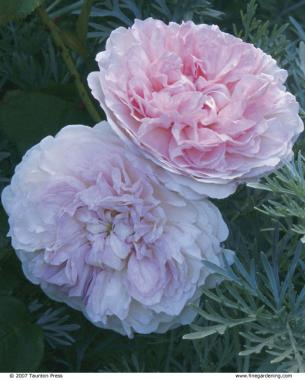
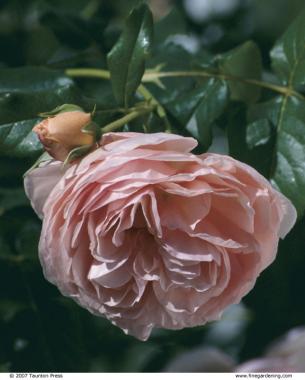
Easy care, but not carefree
Many publications, garden catalogs in particular, describe David Austin’s English roses as being “carefree.” These publications make it sound as if all you have to do is lay back and eat bonbons while these fabulous, fragrant roses flourish effortlessly around you. But the truth is that you will more than likely have to engage in battle with black spot, mildew, and insects from time to time.
Once a week, I try to ward off diseases with a foliar spray consisting of 1-1/2 tablespoons baking soda and 1 tablespoon canola oil mixed well in 1 gallon of water. For insect problems, I also add 1 tablespoon insecticidal soap. This year, frequent sprays of warm, soapy water helped clear up an army of aphids. Last year, during a bad Japanese beetle attack, I used one of the new products made from an extract from the seeds of the neem tree. I sprayed my roses and all my neighbors' roses once a week for three weeks. It appears the stuff really works—only a handful of beetles met their fate under the heel of my shoe this season.
Fertilize, but lightly at first
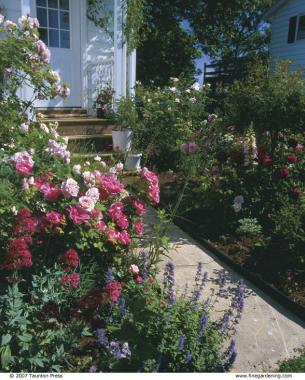
Before planting the new garden, I had to consider the condition of my soil. First, we cleaned up the rusty nails, broken shingles, and plastic cigarette filters that had been left behind by the carpenters. Then I amended my sandy soil using a recipe I'd heard about in Florida, which called for the following items: 5 shovels peat moss, 4 shovels dehydrated cow manure, 1 cup dolomite lime, 2 cups alfalfa pellets, 2 cups cottonseed meal, 2 cups milorganite, and 1/2 cup Osmocote. Mixed together in a wheelbarrow, this is about the right amount for eight roses.
The neighbors find it amusing, but before I plant a rose, I mix up a concoction of goodies including banana skins and the sweepings from my haircuts that I bury about 3 inches beneath the planting hole. An old-timer once told me that when the plant roots reach the mix, they have a feast. Also, my grandmother advised me always to place a dead fish underneath a new rose bush. Whether or not these planting rituals help, my roses seem to be very happy with their diet. Just keep in mind that giving new roses too much fertilizer too soon can be deadly. Go easy on feeding until your rosebushes are well established.
A sneak preview of forthcoming introductions

Photo/Illustration: Katie Lee
Since the 1970s, David Austin has worked to develop additional vigorous, disease-resistant roses. He’s also focused on adding climbing roses to his list of approximately 120 shrub roses. Today, his greenhouse is jam-packed with some 60,000 seedlings, of which only five or six will ever make it to the consumer market.
So which new English beauties can anxious American gardeners look forward to? “My new personal favorite is ‘Eglantyne’,” says Austin, who up until now listed ‘Heritage’ as closest to his heart. “The flowers are perfectly formed—soft pink with a delicious fragrance.”
A departure from the usual pastel palette is ‘Pat Austin’, named after his wife and described as having orange petals with a yellow reverse. The hot colors suit the woman who, Austin notes, is “not the least bit shy or retiring.”
‘Molineux’, a rich yellow, has been winning awards and hearts all over England. ‘Pegasus’, another yellow; the rambler ‘Snow Goose’; and ‘Sophy’s Rose’, a unique light red with rosetteshaped flowers, are also getting rave reviews across the pond. So hurry, mail carrier, speed these catalogs to the door! Because when it comes to English roses, I’ll always have room for at least one more.
Choose complementary neighbors

Selecting the roses was easy. The hard part was deciding on the proper perennials and annuals for neighbors. Fortunately, my preferred palette of pinks, blues, silvers, whites, and lavenders helped narrow the choices. ‘Foxy Hybrids’ foxgloves (Digitalis purpurea), prairie mallows (Sidalcea malviflora ‘Brilliant’), ‘Belladonna’ delphiniums (Delphinium cvs.), Russian sage (Perovskia atriplicifolia), an assortment of lavenders (Lavandula spp.), speedwells (Veronica spicata ‘Icicle’, and V. ‘Sunny Border Blue’) had performed well in my first garden. I found Verbena bonariensis, with its 4-foot stems topped by clusters of small, rosy-lavender flowers, made an eye-catching transition between taller roses. An edging of pink and purple alyssum helped tie all the colors together.
What was missing was something that would spread beneath the roses without competing with them. Something that was beautiful, yet required little care. Something that was unappealing to the billions of bunnies that always seem to be munching on the most expensive plants in my garden. Artemisia ‘Powis Castle’ filled the bill in every way. The silvery filigree of ‘Powis Castle’ has now spread like a carpet under four roses, while the taller plants come up through the lacy foliage without a problem. This was so successful that I tried southernwood (Artemisia abrotanum) beneath the ‘Heritage’ grouping with the same impressive results. I sprinkled in some lavenders and valerian (Centranthus ruber ‘Albus’), with its clusters of white flowers on erect stems, and voila—perfect cottage-garden harmony.

Luck became a factor when I stumbled across anise hyssop (Agastache foeniculum). Apparently it isn't an anise or a hyssop, but it grows to about 3 feet tall with violet flower spikes and has a delightful licorice fragrance. Achillea ptarmica 'The Pearl' looks somewhat like baby's breath on steroids, but it has made a perfect underplanting for the weeping standard rose 'Sea Foam'. I'm also sold on the catmints (Nepeta X faassenii and the taller N. 'Six Hills Giant') as excellent companions for lavenders and any color rose.
Gap problems can be easily solved with annuals and herbs. This year, Swan River daisy (Brachyscome iberidifolia), spider flower (Cleome hassleriana ‘Violet Queen’), bronze fennel (Foeniculum vulgare ‘Purpurascens’), purple sage (Salvia dorrii), Mexican sage (Salvia leucantha), and African blue bush basil (Ocimum basilicum ‘African Blue’) filled in admirably while waiting for some of my perennials to mature.
Not long ago, my British mother-in-law visited us for the first time since our cottage was rebuilt. As she walked through the yard toward the front door, she turned and proclaimed, “What a lovely English garden!” It suddenly occurred to me that now, even David Austin himself might add an enthusiastic “Here, here.”

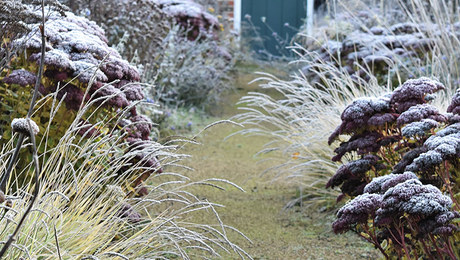
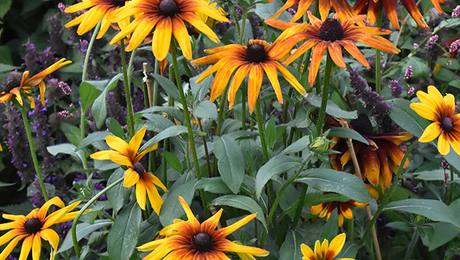
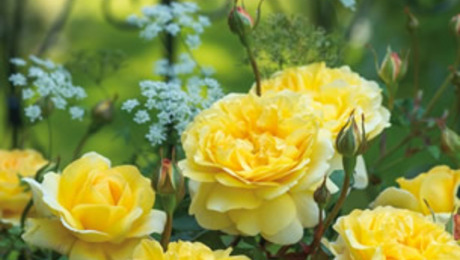
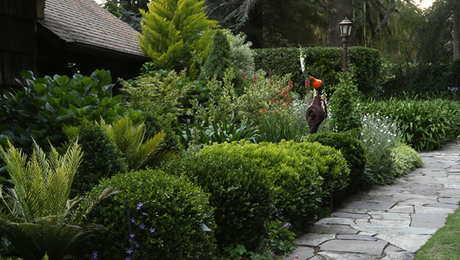












Comments
Log in or create an account to post a comment.
Sign up Log in